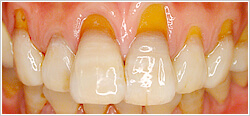Periodontal disease treatment
Bleeding gums are
a sign of gum disease

Do you have any of these concerns?
- Bleeding gums when brushing teeth
- Bad breath or sticky feeling in the mouth
- I feel like my teeth are loose and my gums are receding
- I can no longer chew hard foods
There are various symptoms that people may recognize as "periodontal disease" or "pyorrhea." It is said that about 80% of adults have periodontal disease, including those at risk.
Even if you have no cavities, periodontal disease may be progressing. Understand the correct prevention and treatment methods to keep as many teeth as possible.
Periodontal disease affects many parts of the body
Periodontal disease is the number one cause of tooth loss. When you lose your teeth, you are unable to chew properly, which has a major impact on the entire body.
Recently, it has become clear that periodontal disease is related to various illnesses throughout the body, and it has been pointed out that it is related to heart disease, including myocardial infarction, respiratory diseases, diabetes, arteriosclerosis, premature birth, and miscarriage.
Treatment methods for periodontal disease
- Visual examination and confirmation of the main complaint
First, we will ask you to show us the treatment status of your mouth. We will then ask you about any pain or symptoms you may have regarding your teeth.

- Panorama shooting
We will take X-rays of your entire mouth to
check how much alveolar bone (the jaw bone that supports the teeth) has been lost and measure the periodontal pockets of all teeth to determine the extent of your periodontal disease.
- Plaque Control
We will practice brushing so that you can remove plaque, which causes periodontal disease, by yourself. We will
focus on areas that are difficult to brush by yourself, such as between teeth, and areas that are not brushed well due to bad brushing habits. We will teach and practice not only toothbrushes but also auxiliary cleaning tools so that you can learn them.
- Scaling and Root Planing
Scaling is the removal of tartar, which is a habitat for periodontal bacteria. For a while after the procedure, you may notice gaps between your teeth or feel that your teeth are longer, but this is proof that the tartar has been removed and your teeth are in good condition.
Root planing is the process of smoothing the roots after tartar has been removed. Plaque and tartar accumulate in the roots, which cannot be seen with the naked eye. This is removed with special tools to make the surface smooth and prevent bacteria and dirt from re-adhering.
* Local anesthesia may be administered if necessary.
- maintenance
Once you have finished your periodontal disease treatment, it does not mean that you do not need to do anything else. If you have had periodontal disease once, there is a possibility that you will get it again. Regular maintenance is important to prevent recurrence. Maintain
a healthy oral environment by undergoing oral examinations, professional cleaning, scaling, oral hygiene instruction, fluoride application, and other examinations as necessary.
Other Periodontal Disease Treatment Methods
Periodontal surgery
If the periodontal disease is relatively mild, it can be cured by continuing treatment to remove dirt on the teeth and around the teeth and keep them clean.
However, if the inflammation progresses deep into the gums and the periodontal tissues of the alveolar bone (the bone that supports the teeth) and periodontal ligament (the muscle fibers that connect the teeth and alveolar bone) are severely destroyed, surgery (periodontal surgical treatment) to restore the periodontal tissues is required. To help ensure the effectiveness of this treatment, the latest treatment methods include Emdogain treatment and GTR treatment.
Cases of connective tissue grafting
[Before treatment]

The gums have receded and the roots of the teeth are visible
[After treatment]

The gums now cover the roots of the teeth, improving their appearance.
Periodontal treatment
Simply put, it is a "bacterial elimination treatment for your mouth (periodontal disease)." It
is a treatment method that examines the type and number of bacteria in your mouth using a microscope with a monitor, and then uses medicine and toothpaste that matches the bacteria to thoroughly sterilize your mouth.
Even if periodontal disease is not advanced, sterilization methods can help prevent future periodontal disease from progressing.
Frequently asked questions about periodontal disease
What treatments are available for loose teeth?
There are two ways to stop this shaking: adjusting the bite (occlusal adjustment) and fixing it.
What kind of treatment does "fixation" involve?
Fixation means connecting loose teeth to the teeth next to them.
When the teeth are connected, they stop moving. By connecting the loose teeth, they support each other. Once the teeth have stopped moving, we can begin brushing and removing tartar, which is the most important part of treating periodontal disease. Fixing the teeth allows you to chew properly and helps the teeth last longer.
People who viewed this page also viewed these pages:

